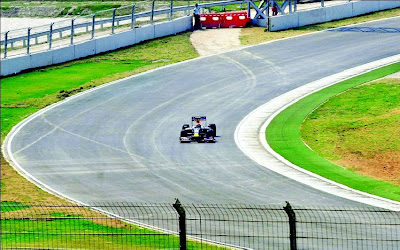Wednesday, February 29, 2012
Delhi IGI Airport ranked Second-Best Airport in World for 2011 by ACI
The airports of Delhi Hyderabad
While the Indian airports ranked among the top in different categories, the ACI declared Incheon in Seoul, Changi in Singapore, airports in Hong Kong, Beijing and Shanghai Pudong as the overall top ‘best airports worldwide’.
The rankings were done on the basis of a global ASQ survey by the ACI of 153 airports, including 6 Indian ones.
The survey, which gets a representative sample of flights, destinations and passenger groups served by the airport, is intended to get feedback from users on a range of service delivery parameters. ACI audits the process to ensure compliance and validates the results.
The awards will be formally presented in April at the ACI’s Asia-Pacific Regional Conference to be held here.
Tuesday, February 28, 2012
India is ready for testing First ICBM Missile Agni-V (5000 Km)
Saturday, February 4, 2012
ISRO launched PSLV-C18 successfully
The Indian Space Research Organization on Wednesday used a strategic delay to evade a possible encounter with space debris and ensured a perfect launch of the PSLV-C18. Lifting off from the Sriharikota spaceport at 11.01 am , a minute after its designated time, ISRO’s workhorse PSLV put in orbit three satellites, including the Indo-French Megha-Tropiques. With this, the PSLV, which was inducted in 1993, exceeded a half century of satellite launches. “The launch was a great success. We had targeted a circular orbit of 867 km for weather satellite Megha-Tropiques and we have achieved, as per initial reports, 865 km,” said ISRO chairman K Radhakrishnan. “It demonstrates again the reliability and versatility of PSLV as a launch platform.” After beginning the 50-hour countdown at 9 am on Monday, ISRO got wind of the space debris. Three hours before the schedule lift-off time, it found that the probability of collision remained high. “We delayed the launch by a minute as there was a higher probability of the launch vehicle hitting space debris at an altitude between 600 km and 800 km,” an official said. One minute is a significant amount of time in this context as any object in space at that height moves at 8 km/second. The delay ensured that the rocket reached the altitude after the debris had moved away by about 500 km and the satellites could be safely ejected into the orbit. The 1,000kg Megha-Tropiques, put in orbit 22-and-a-half minutes after the rocket lifted off, was jointly developed by ISRO and French national space agency CNES. It will study the water cycle and energy exchanges in the tropics. Its circular orbit is inclined at 20 degrees to the equator allowing it to cover more area on both sides of the equator. “It will help us understand our climate better. This knowledge will also help our farmers,” said Radhakrishnan. It is only the second satellite of its kind in the world. The first, Tropical Rainfall Measuring Mission (TRMM) developed jointly by the US Japan India France Luxembourg
Indian Missile Agni-V
Agni-V, with a strike range of over 5,000 km, would be test-fired for the first time between December-February. The 20-tonne Agni-IV (3,500km) and 50-tonne Agni-V will add much needed muscle to India’s nuclear deterrence.
If launched from the North-East, would be able to hit high-value targets deep inside China.
DRDO claims both Agni-IV and Agni-V comparable to the best missiles in their class, including Chinese.
Agni-IV and Agni-V will have higher accuracy, fast-reaction capability and road mobility.
They provide operational flexibility against China as they are capable of being stored and swiftly transported.
DRDO is confident of offering 17.5-metre tall Agni-V for induction by 2014.
India successfully tested Agni IV Missile
India on Tuesday successfully tested a new-generation Agni missile with a strike range of 3,500 km and souped-up “kill efficiency”, prompting excited defence scientists to proclaim it would add “fantastic deterrence” to the country’s nuclear weapons programme. The test of the “most advanced” surface-to-surface missile called Agni-IV also launched the countdown for India to test its most ambitious strategic missile Agni-V, which will have near-ICBM (intercontinental ballistic missile) capabilities with an over 5,000-km range, in December-January. “This test has paved the way for the success of Agni-V mission, which will be launched shortly,” said DRDO’s chief controller (missiles and strategic systems) Avinash Chander. The Agni-IV incorporates many new technologies in navigation, propulsion, avionics and other areas to represent “a quantum leap” in missile technology for India. Having inducted the Pakistan-specific Agni-I (700-km) and Agni-II (over 2,000-km) missiles, the armed forces are now in the process of operationalizing the 3,500-km Agni-III after completion of its developmental and pre-induction trials last year. The two-stage Agni-IV and three-stage Agni-V, in turn, are meant to add some much-needed credible deterrence muscle against China, which has a massive nuclear arsenal with missiles like the 11,200-km Dong Feng-31A capable of hitting any Indian city. The canister-launch Agni-V, with its high road mobility and fast-reaction ability, in particular, is being talked about as a small but sharp riposte to China. The Agni-IV represents a significant step towards this objective. Though it was tested for a 3,000-km range, it can easily go up to 3,500 km. The missile, however, will have to be tested several times before it can be ready for serial production and then induction.
The Buddh International Circuit
It promised to be spectacular and it has lived up to the billing. The Buddh International Circuit, India India
Subscribe to:
Comments (Atom)





